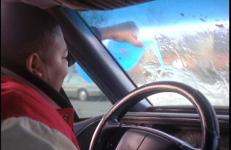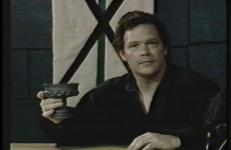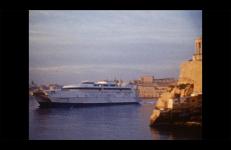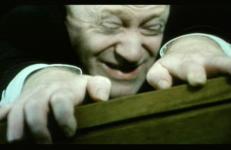Company Line is a film about one of the first predominately Black neighborhoods in Mansfield, Ohio. The title, Company Line, refers to the name historically used by residents to describe their neighborhood, located on the north side of town close to the old steel mill. The Company Line began during the post–war migration of Blacks from the south to the north in the late 1940’s. The neighborhood was purchased in the early 1970s and its residents were scattered throughout Mansfield.
Experimental Film
Resisting the regime of the counter-shot, this experimental short fiction film follows the story of Alex on the eve of Le Pen’s defeat in the 2002 French presidential election. A well-meaning American writer, they must face a bombastic inner voice before it ruins a friend’s act of eco-terrorism and the relationship with girlfriend Oona.
During my stint as an entry-level acquisitions scout at a now-defunct art house distribution company, I amassed a small collection of VHS tapes from a vast pool of unsolicited submissions. By the standards of the art house canon, these were very bad movies, but I adored them for the sincerity of their intention. Bits and pieces of these movies became source material for a number of the videos on this compilation (Teenagers, Hymn Of Reckoning, Fantasy Suite).
Here, a double morphology of conversion forces us to think about the trance of non-reconciliation, outburst and trance that go through the centuries of colonial violence until reaching us in the tension of an audiovisual disjunction: visible and enunciable. On the one hand the museum, habitat of barbarism, on the other hand the voice, place and body of the furious testimonial. Religious conversion that conveys communal violence. Archaeological conversion that imposes object immobility.
This is the invocation to the gods, the incense to the gods. A kinetic dance to the gods. Behold the hieratic nature of Tonatiuh (The Sun) and the ferocity of Tlaltecuhtli (Goddess of the Earth) raising her agitation from the white smoke of the burned Copalli, Mesoamerican aromatic resin, sacred resin that tears celluloid with smoke, white hair, on the dark background of the world.
Coral is part of the harmonic and hyperkinetic colors film series. In this part the transcendental experience of his harmony leads us to an aesthetical suspension of content. Part of the Harmonic and Hyperkinetic Color Film Series.
Coyolxauhqui recasts the mythical dismemberment of the Aztec Moon goddess Coyolxauhqui by her brother Huitzilopochtli, the deity of war, the Sun and human sacrifice. The film is a poem of perception, one that unveils how contemporary Mexican femicide is linked to a patriarchal history with roots in deeper cultural constructs.
This is the howl, gaze, and agitation of the Coyote into the mountain. The Path of the Coyote.
This is the crude and unnatural state of civilization, an image not yet processed or refined that hides and displays in its intermittence all the crude violence of the anthropocenic industry. The raw and fossil image of the Capitalocene. Part of the Hauntology series.
In Danza Solar, Super8 archival footage of dancers is superimposed with 16mm views of the sun (suns). The film evokes a communal solar trance, both Andean and Mesoamerican. Part of a collection of works the collective considers "Shamanic Materialism," Danza Solar is a Mesoamerican spell unleashed.
A brief glimpse into the cycles of Coyolxauhqui, the moon goddess, whose cycles used to be a dance. A fast-paced jazz soundtrack accompanies the quick, darting movements of the moon.
These are the ghosts of a haunted civilization, a culture of progress that hides the social and political horror behind the streets. These are the haunted figures in the Capitalocene era. A sinister dance of macabre abstraction. A scanner darkly of the streets. Part of the Hauntology series.
“His heart was a dark cave filled with sharp toothed, fierce clawed beasts that ran snapping and tearing through his blood. In pain he left the work table and prowled around the room, singing to himself, ‘Who can I be tonight? Who will I be tonight?’”
—Alfred Chester, Exquisite Corpse (New York: Simon and Schuster, 1967)
A Kafkian vision of the New World. The arrival of Karl Rossman to the contemporary Babylon under the spell of the paranoid avant-garde. Kinetic coexistence of the archaic forms in dissolution.
A hypnosis-inducing pan-geographic shuttle built on brainwave-generating binaural beats, Deep Sleep takes us on a journey through the sound waves of Gaza to travel between different sights of modern ruin. Restricted from travel to Palestine, I learned auto-hypnosis for the purpose of bi-locating. What results is a journey, recorded on Super 8mm film, to the ruins of ancient civilizations embedded in modern civilization in ruins, to a site ruined beyond evidence of civilization.
A modulation of the discourse produces a portrait of the philosopher Slavoj Žižek during a dialogue.
Nazlı Dinçel’s hand-made work reflects on experiences of disruption. They record the body in context with arousal, immigration, dislocation and desire with the film object: its texture, color and the tractable emulsion of the 16mm material. Their use of text as image, language and sound imitates the failure of memory and their own displacement within a western society. Born in Ankara, Turkey, Dinçel immigrated to the United States at age 17. Dinçel resides in Milwaukee, WI where they are currently building an artist run film laboratory.
This are the scattered fragments, the scattered mineral fragments in its oceanic evolution, an intermittent becoming of geological massiveness. The mineral geology under the spell of an scattered dance. This is the mobilized fossil. Part of the Scattered Geology Audiovisual series.
First of all: a dissolving is a structural device of the history of audiovisual language. Second: this piece is about a rearticulation of the dissolving device that captures the ominous historical and political events in recent Mexico.
Done To (alternately titled It Is, Done To) consists of simple still-frames accompanied by a complex, incongrous soundtrack, or silence. There are instances where image and sound coalesce; however, the majority of the images are overwhelmed by the at-times symphonic, at-times cacaphonous soundtrack, displacing the normal film viewing experience. The standard film format of going from frame to frame — and then and then and then — is what this film is concerned with.
Imagine that the camera is possessed with a psychosis similar to human schizophrenia; suppose that this disease subtly changes every single frame of film while leaving the narrative superficially intact. Then imagine that these symptoms came on as a result of the trauma of recording bizarre or horrific events, for instance those of the 1941 horror film Dr Jekyll and Mr Hyde...
Adapted from the novel by Robert Louis Stevenson.
This title is also available on Paul Bush Pixilated.
The Dresden Codex is a prehispanic book that was kidnapped and was rediscovered in the city of Dresden, Germany. It keeps a presage of a destruction to come.




























